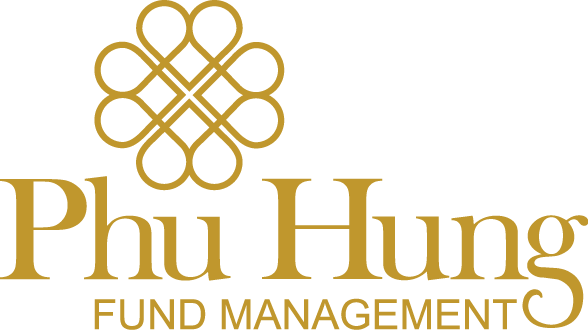1. Retail to bounce back strongly after social distancing.
In 2021, the Retail sector experienced dramatic turbulence in revenue due to the Covid-19 pandemic. Although the strict social distance measure caused the heaviest decline in retail sales in the third quarter of 2021 (-28.3%YoY), the release of the high suppression on demand brought a quick recovery in the fourth quarter after lifting the social distancing. Total retail sales of consumer goods and services reached VND 4,790 trillion, down 3.8% compared to the previous year.
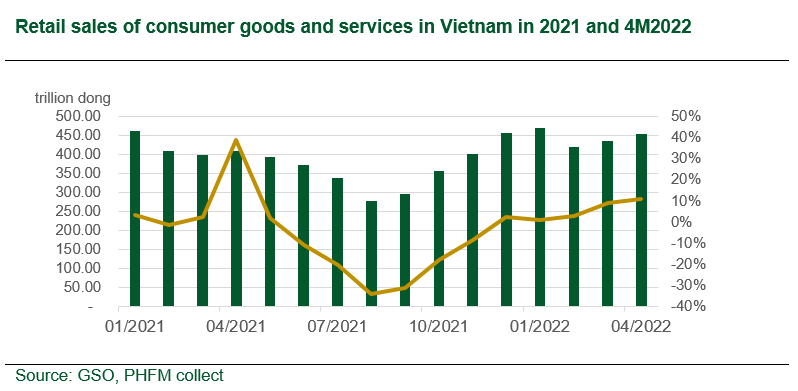
The recovery in purchasing power continued in the first four months of 2022, with total retail sales of consumer goods and services reaching VND 1,777 trillion, up 6.5% over the same period last year. In which, retail sales of goods, travel, accommodation & meals increased by 7.6%YoY, 10.5%YoY, and 5.2%YoY, respectively. The retail industry is assessed to recover faster than other industries after social distancing thanks to (1) Rapidly increasing consumer demand as Vietnam has achieved a high vaccination rate – this is the key to preventing the social tightening and helping to rehabilitate the economy. The laborers began to return to work, and their incomes began to strengthen, thereby participating in a more vibrant shopping market. In addition, the reopening of tourism stimulated shopping and consumption. Specifically, in the first four months of 2022, international visitors to Vietnam reached nearly 192.4 thousand arrivals, three times higher than the same period last year; (2) Businesses flexibly respond to the Covid-19 pandemic, as well as grasping new consumption trends/behaviors and offering promotions and consumer demand stimulation programs after the pandemic. Domestic enterprises strive to build a technology foundation in market research, product marketing, and data analysis on shopping behavior/preferences to provide the right quality of products and best services to consumers; as well as building an integrated value chain from production to retail to bring quality products with lower prices than foreign enterprises. Besides, the Government has effectively organized the circulation of goods, ensuring to meet the needs of consumers.
2. Consumer trends in the “new normal” period.
Using more electronic devices: The prolonged Covid-19 pandemic has changed consumers’ shopping behavior, shifting from offline to online shopping during social distancing. Vietnamese consumers, especially the elderly, are starting to get used to accessing the Internet and researching product quality/price at e-commerce sites or social networks. According to data from iPrice, Shopee and Lazada are the top two E-commerce sites in Vietnam, with monthly visits in Q3/2021 of 77.8 million and 21.4 million, respectively. Vietnam is considered a country with the highest percentage of new online shoppers compared to the region at 41%. After the social distancing period, Vietnamese consumers maintain an online shopping time of 4.2 hours, higher than the online shopping time before social distancing of 3.7 hours. The habit of studying and working online is maintained after social distancing; typically there are many online meeting held by firms or prepared lectures by teachers through laptops.
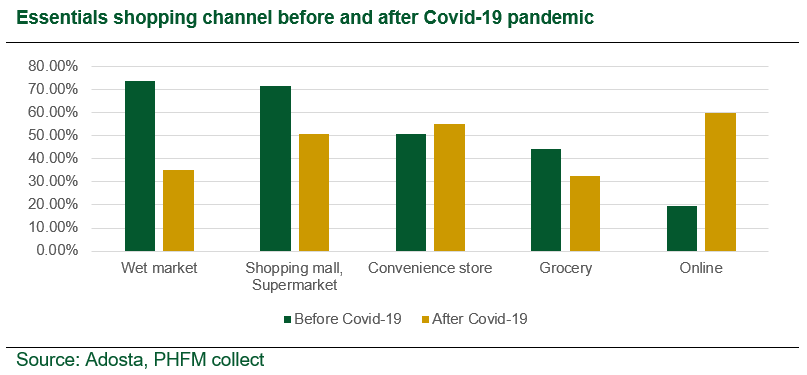
More attention to health: The pharmaceutical retail industry began to grow rapidly as Vietnamese consumers cared about their health amid the outbreak of the Covid-19 pandemic and the alarming situation of environmental pollution. BMI forecast that the pharmaceutical industry’s growth in 2024F (a period that Covid-19 would be well controlled) could remain at ~9%, higher than the 2019 growth rate of 3.6%. Pharmaceutical retail chains such as Long Chau and An Khang would benefit long-term.
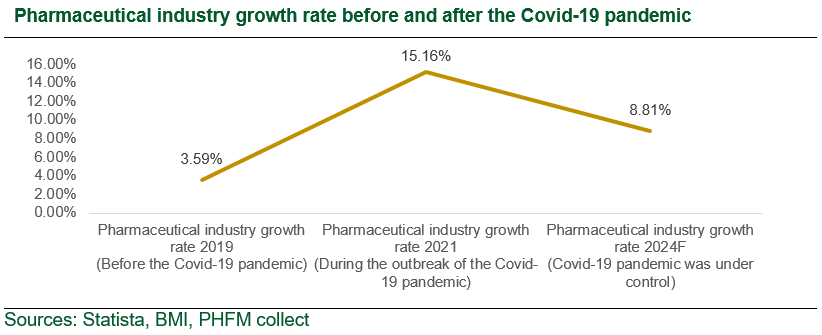
Digital transformation and omni-channel are important keys to help retailers overcome market fluctuations: To keep up with “trends” in changing consumer shopping behavior during the Covid-19 pandemic, many enterprises promote sales on E-commerce and online platforms. According to Sapo statistics, the percentage of businesses converting their business from offline to online (accounting for 72.8%) – is an increase of 9% compared to 2020 (63.8%). The proportion of enterprises that only focus on offline business and not online business decreased from 36.2% (in 2020) to 20.9% (in 2021). Online channel revenue of leading enterprises in the industry grew strongly amid the outbreak of the Covid-19 pandemic. Specifically, the online revenue of the Bach Hoa Xanh chain increased by four times compared to 2020, or PNJ’s online revenue accounted for 30% of total revenue, 2-3 times higher than in the pre-pandemic period. Typically, the retail market share of MWG, FRT, and PNJ soared in 2021.
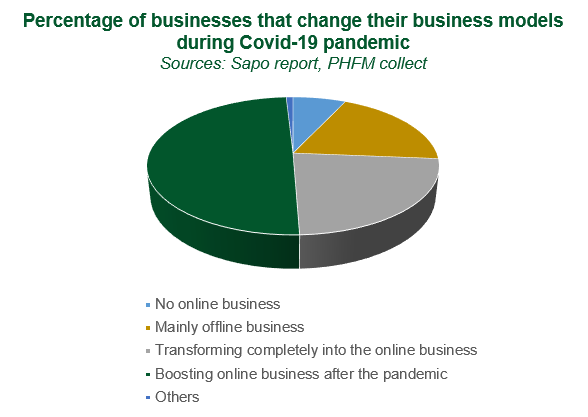
3. Maintaining a positive outlook of the retail industry in the long term
We estimate the growth rate of Vietnam’s total sales of consumer goods and services in 2022 to increase by 15% -17% YoY, of which retail sales of goods could be at 8-10% YoY. In the long-term, the positive outlook for the retail industry could maintain thanks to the following long-term growth drivers
-
Strong growth in the economy and per capita income: According to EUI, the CAGR growth rate of Vietnam’s GDP in 2022-2024 would be ~7.1% – the fastest growth in the region of Southeast Asia. Therefore, per capita income has the fastest growth in the region, with a CAGR of ~13%, double the growth rate of the second-ranked country, Indonesia (6.2%). According to World Data Lab, Vietnam will have 23.2 million more people in the middle class by 2030 and is forecasted to be among the countries with the largest increase in the number of middle-class people in the current decade. Euromonitor estimates that personal consumption expenditure in Vietnam accounts for 67% of GDP, ranked second in the top countries with the largest consumption expenditure in the region.
-
Rapid urbanization: Currently, big cities are the main growth drivers for retail businesses. In 2025 and 2030, the urbanization rate in Vietnam is expected to be 45% and 50%, respectively.
-
Young population structure: Vietnam’s retail market is one of the five most potential retail markets in Asia and globally because Vietnam has a large population (> 97 million people), a young population structure with 60% of the population from 18-50 years old – this is the age with the highest priority for consumption in the income structure.
-
The excitement of modern retail channels and E-commerce: Although the traditional retail channel accounts for 74%, the growth rate is only 1%. On the other hand, the modern retail channel accounts for 26% market share but grows double digits at 11.8%/year. Hence, the modern retail channel could “overtake” the traditional retail channel soon. Specifically, the proportion of retail sales of goods by modern distribution methods (commercial centers, supermarkets, convenience stores, etc.) could reach 50% by 2025 and 60% by 2030. Moreover, the level of Internet access for shopping among Vietnamese people is increasing; there are about 64 million internet users, of which the percentage of Internet users participating in online shopping accounts for 88%.
-
Retail industry Vietnam – an attractive destination for foreign investors: According to data from the Foreign Investment Department (Ministry of Planning and Investment), by the end of 2021, foreign investors have invested in 18 industries out of 21 national economic sectors. In which, wholesale & retail is the fourth largest capital attraction sector (after the processing and manufacturing industry; electricity production and distribution; real estate business) with a total registered capital of over USD 1.4 billion. In terms of the number of projects, wholesale & retail are one of the top 3 industries attracting the most projects with a 28% rate of the total projects. The retail industry is expected to attract more M&A deals in the long term.
